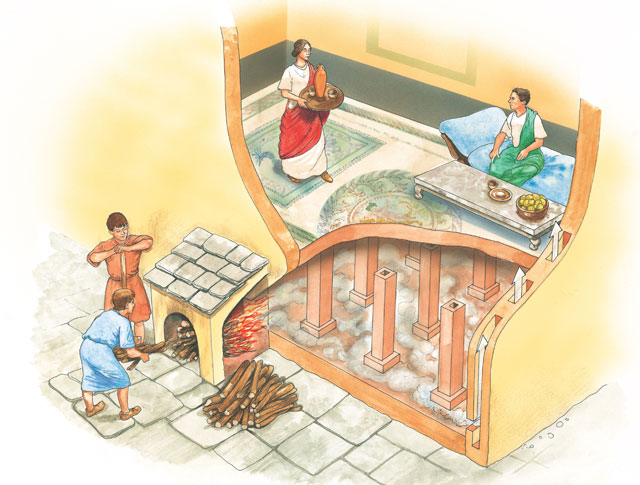While state of the art technology is used in the radiant heating of today providing unparalleled comfort, the basic concept of radiant heating has been around for thousands of years.
Radiant heating was first used in Korea as evidenced by excavated artifacts from the Iron Age (circa 2nd century) and wall paintings called Goyuryeo. Ondol, the earliest heating system, 1000 B.C., originally only heated parts of rooms by hearths which were used for cooking and heating. The fire from the hearth would heat stones throughout the room which then radiated that heat outwards heating the room.
It was not until around the 13th century that the technology was created to heat an entire room. This was accomplished by using the gorae which is the open area under the floor from which the smoke from the heated stones passes underneath the floor. Above the gorae are flat wide stones covered by red clay, which keeps the smoke from leaking out. When a fire is lit in the fireplace the fire and smoke travels through the gorae which in turn heats the floor above it, passing through a chimney at the end of the room. This ancient system utilized the principles of convection, radiation and conduction. Heat is conducted through the stones then radiates outward through the entire floor through the gorea and the warm temperature is maintained through convection.
Similar systems were also used in Northeast China and Mongolia. China used an earlier system heating only parts of the bedroom. While in Mongolia the system was used to heat the floors of their yurts. An Ondol type of sytem was also used in the Aleutian Islands in Alaska around 1000 B.C.
Later in the Middle Ages around 1300 BC underfloor heating systems appeared in Turkey in the middle east. King Arzawa installed this system in his palace in Bwycesutan, Turkey around this time. These systems were also used to heat the Turkish Baths during the Ottoman Empire.
Around 80 BC the Romans, advanced the technology considerably with the introduction of the hypocaust system. These systems were not cheap and were used to heat upper-class Roman homes and were also used to heat Roman baths. They were designed by Sergius Orata and at first only heated the floor through a system using the same principle as the Ondol system. These systems were built with a stone floor built on pillars with a fire at one end. The empty space beneath the floor was called hypocaust and the hot combustion gases passed through this empty space to the other side. Originally these systems just heated the floor but evolved to also heat the walls through tile flues or hollow wall tiles. Some of these floors had vents allowing hot air to move into the room. After the fall of the Roman empire the technology to heat through hypocaust systems was lost and there was very little advancement during the dark ages.
Later the fires were moved outside and maintained round the clock by slaves or servants. These systems were very efficient maintaining a floor temperature of between 77 to 95F and wall temperatures of between 66 to 90 F.
In India around 1500 the Lotus Mahal, Hampi, Karnataka, used cool water in wall pipes for cooling. And in Holland Cornelius van Drebbel invented automated temperature control to regulate the temperature of ovens.
These systems have lasted through the centuries because they are efficient, clean, economical and allergy free.
